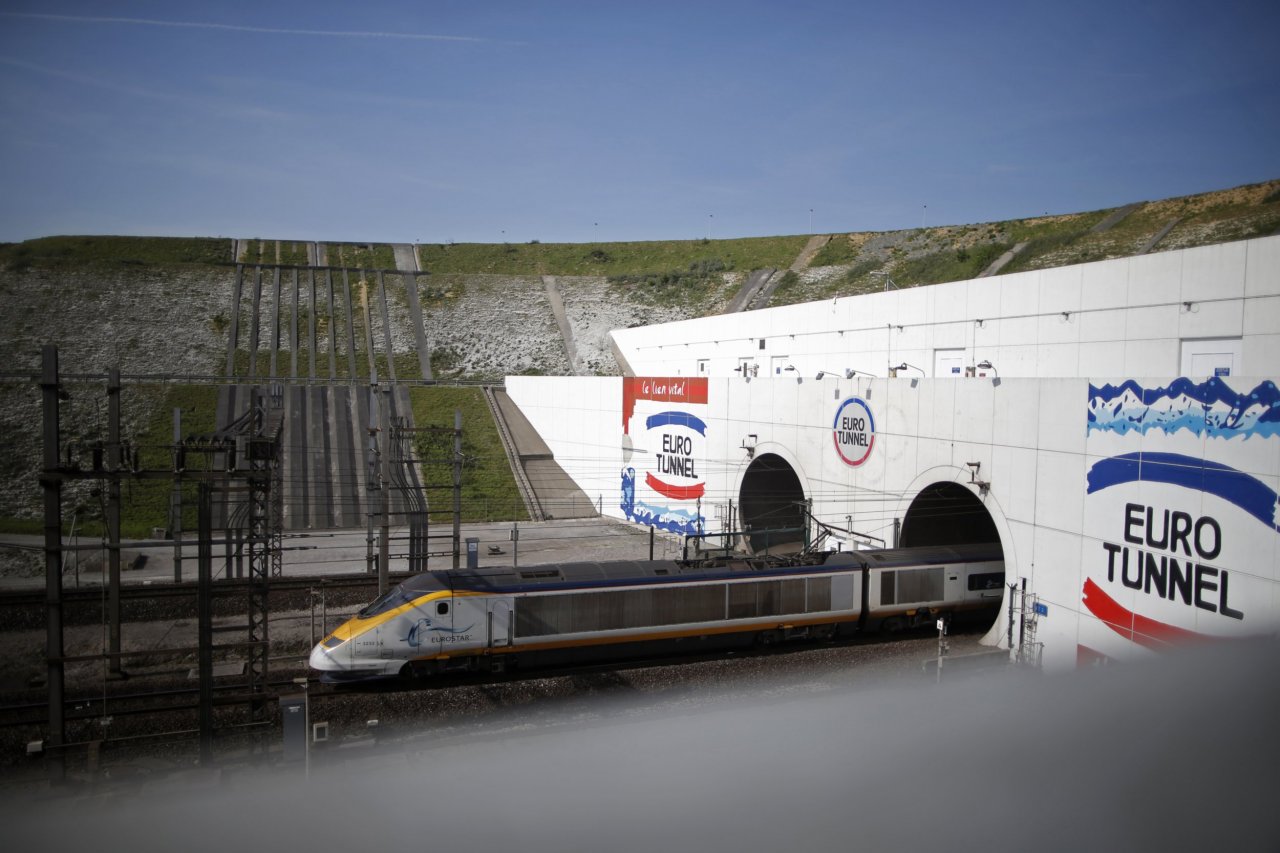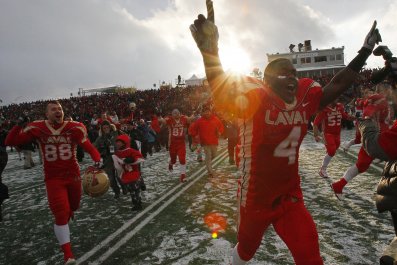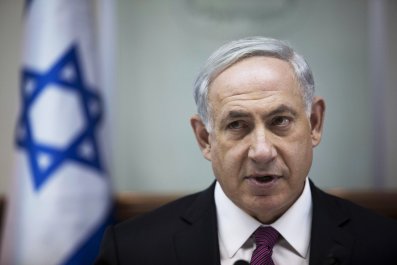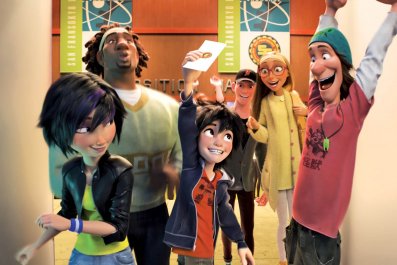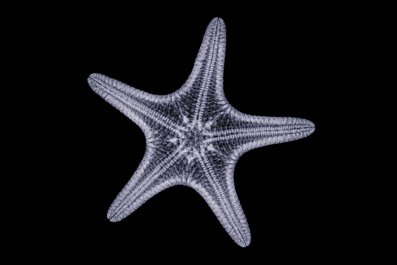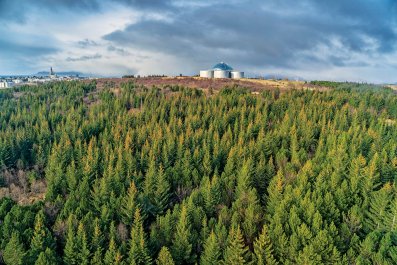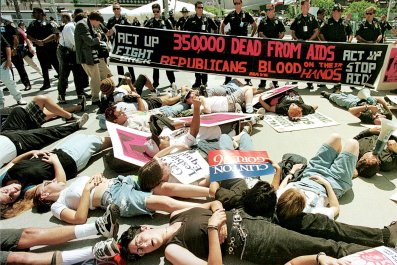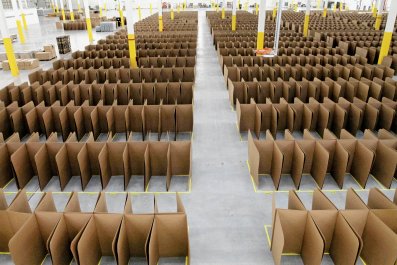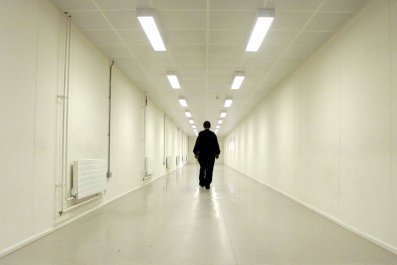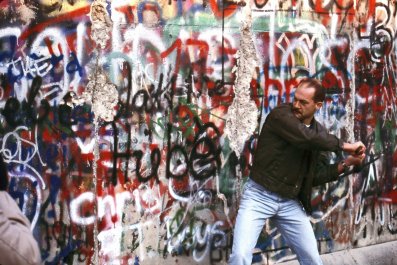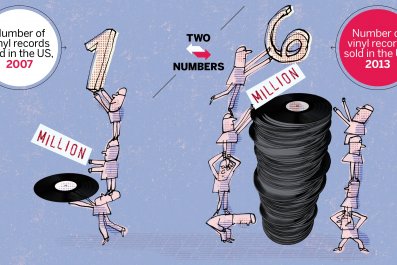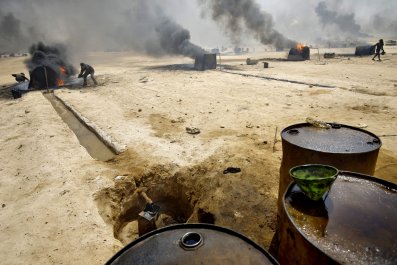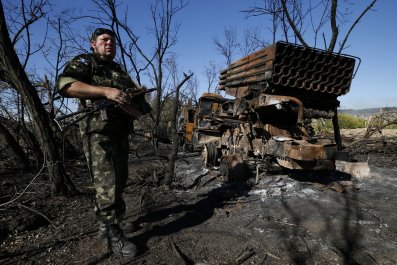Eurostar is 20 years old on November 14th. Celebrations will be held at the train's terminus, St Pancras International, which, in fact, always looks celebratory. One reason for choosing it as the terminus was to show off the train under the soaring iron and glass train shed (the perfunctory term the Victorians applied to their railway palaces). Before St Pancras was refurbished for Eurostar, the few trains seemed embarrassed by their operatic surroundings, and the adjacent Midland Grand hotel – now open for business as a glamorous complement to the train – was semi-derelict, in effect the most famous haunted house in London. Today, a Eurostar is usually lined up waiting alongside Searcy's champagne bar, the longest in Europe, along which 1,372 champagne flutes can be accommodated.
There is much to celebrate: operating profits rose from £52m to £54m last year, and the train carried more than 10 million passengers for the first time. Eurostar carries more people than all the airlines combined on the inter-city cross-channel routes it serves. It has done so since 1997 on London-Paris, and since 2004 on London-Brussels. Nicola Shaw, Chief Executive of High Speed One (the line over which the train runs) muses: "It is now very unusual for someone to go between London and Paris by any other method. Perhaps people who live near Heathrow or Charles de Gaulle airport might fly."
Next year, ten new Eurostar trains will be delivered. They will be "sleek, stylish and modern", and the existing trains will be refurbished in their image. From next year, there will be direct services to the South of France year-round, rather than in summer only; and direct services to Amsterdam.
Customer satisfaction is high and the train gets rave reviews from transport specialists, although with caveats. Stephen Joseph, chair of the Campaign for Better Transport, says: "Eurostar is enormously successful. It's proved that rail can take a big share of international travel, but it's taken a while to do that." (Eurostar was originally predicted to reach the 10 million figure in 1998).
John Stewart, chair of Hacan Clearskies ("A voice for those under the Heathrow flightpath") says: "Because Eurostar is so much more convenient than the plane, the shorthaul flight market has shrunk dramatically. So that's a great saving on emissions and noise. It's just a pity the fares are so expensive." (To which the Eurostar people respond that the train has beaten the planes, therefore must be deemed competitive on price.)
The design critic Stephen Bayley has described the Eurostar service as "delectable", while counselling that it is "not just a matter of getting the flaneur to Paris more quickly".
I count myself among the flaneurs. I travelled in the very first week of Eurostar, in a carriage full of trainspotters carrying cheese sandwiches to the gastronomic capital of Europe. I took similar trains, and in 1996 I was commissioned to write an article about Motor Books, a rail enthusiasts' mecca in the West End. The proprietor told me that rail enthusiasm was undergoing a revival, becoming cool. Not to the extent that he was willing to tell me the names of his "many celebrity clients". (They included, I happen to know, the rock musician Peter Gabriel, the actor Anthony Hopkins, the art critic Brian Sewell). But he did say, "They're not into freight wagons and diesel multiple units; they're all into Eurostar and the French high speed trains." Eurostar was not yet high speed on the British side. But it was essentially a modified version of the French Trains Grand Vitesse (TGV) that had started operating in France in 1981.
The coming of the TGVs confirmed the Francophilia inherent in British train enthusiasm. The French were deemed more serious about trains than the British, even though Britain invented trains, a fact magnanimously acknowledged by the presence of a bust of the steam pioneer James Watt at Gare du Nord. The discrepancy has been put down to the fact that Britain never had a standing army, and so lacked the sense of strategic imperative that dictated a properly planned, state-funded railway.
The prejudice goes back along way. Charles Dickens deplored British railway catering, and his story, The Boy at Mugby, begins, "I am the boy at what is called the Refreshment Room at Mugby Junction, and what's proudest boast is that it never yet refreshed a mortal being". But he loved the catering at Calais: "bottles of wine, plates of meat, roast chickens . . . basins of soup, little carafes of brandy, cakes and fruit." He visited Calais on the boat trains of the South Eastern Railway, which he blessed "for realising the Arabian Nights in these prose days".
The smartest British trains were always those connecting with the Channel boats. They featured many luxury Pullman carriages, whose hallmark was the pastel-shaded table lamp deliberately referenced on Eurostar. The most famous was the all-Pullman Golden Arrow (1929-72), which pre-empted Eurostar in attempting to make the journey from London to Paris as seamless as possible. There was a dedicated boat for the Arrow passengers, which had a Palm Court lounge and a restaurant that mimicked a Parisian brasserie. The words "Sea Slight", chalked on a board at Victoria, meant there was a probably of seasickness on the crossing, but this was countered by the availability of complimentary pills – Aspro's – on the train; also quarter bottles of champagne (still available on Eurostar) because it was found that passengers liked to brace themselves with a small amount of alcohol on the approach to Dover. On arrival at Calais the baton was passed to the Arrow's French counterpart, the Fleche d'Or, and lunch was announced (somewhere around Boulogne) by the guard walking along the train and tinkling a bell.
The Arrow tried to compensate for the absence of a Channel Tunnel, which was first proposed in 1802 by the French engineer, Albert Mathieu, who envisaged a tunnel with an artificial island in the middle where the horses that pulled the carriages could be changed. Subsequent schemes were put forward whenever Britain was on friendly terms with France, but the security concerns of the military always intervened. The British military, that is. Since it guaranteed its island status, the Channel has always been more British than French.
By the early 1980s, the cross-channel airlines which had been overshadowing rail travel between Britain and Europe for 60 years had removed the security objection. It couldn't apply when thousands of people were flying daily across the Channel. So the success of the planes facilitated Eurostar which has in turn defeated the planes and created a climate in which plans for High Speed Two can flourish.
The digging of the Channel tunnel began in 1988 and was completed in 1994. Apparently, Margaret Thatcher would have preferred a road tunnel, but there were ventilation issues, and the interesting problem of "driver mesmerisation".
On the French side, Eurostar ran over one of the TGV lines. On the British side, the British used ordinary lines, and so the train ran at less than high speed. "Classic" speed we might say, to be polite. Apparently President Mitterrand was not particularly polite to Thatcher when they travelled on the inaugural journey, disparaging the pace of the train.
The point was taken, and we have Eurostar to thank for the coming of the high-speed line on the British side. Jim Steer, a civil engineer, who founded Greengauge 21 to research high-speed rail for Britain, puts it like this: "You had this train that could reach 186mph. You might as well build a line to let it do that."
But in Britain – lacking the dirigiste French culture – the task would always be fraught. The original, low speed Eurostars had come into Waterloo International, a lovely sinuous annex to the main station, and a reproof to its Victorian sprawl. (This annex, currently being adapted for use by ordinary commuter trains, is one of the beneficial Eurostar spin-offs). But Waterloo International was always temporary; the plan from the outset was that Eurostar would eventually come into north-east London.
A subterranean station beneath King's Cross had been in the frame, along with St Pancras and Stratford in east London. St Pancras won because there was space to build a northward extension to accommodate domestic services, and because it was stylish. The approach would be through east London, a decision credited to Michael Heseltine, that promoter of urban regeneration under the Conservative prime minister, John Major.
The industrial wasteland around the Thames Estuary was to be taken in hand. Having been passed over as the terminus, Stratford would at least be given a station, Stratford International. There would also be Ebbsfleet International, 10 miles beyond the eastern boundary of London, and these two would supplement Ashford International in mid-Kent, which had been built on the slow line, but had the fast line threaded through it.
"International" is a dubious boast in some of these cases and railway traditionalists think it's pompous. Victoria station was never "Victoria International" even when dozens of boat trains left there every day, and "India" was advertised impressively (if rather vaguely) as a destination.
There is another reason – besides regeneration – for this focus on north-east London. I picked up a pamphlet on one of my first journeys – Eurostar, The Easy Way to Europe – whose final section is headed "What's Next?". It begins with the astonishingly brazen declaration: "From mid-1996 a full Eurostar service will operate from Manchester . . . Later in the year the service will extend to Glasgow, Edinburgh and Birmingham." The reference is to those fabled ghost trains, the Regional Eurostars. They were supposed to circumnavigate central London en route to Europe. They would – according to the plan – hook up with the high speed line at Stratford, which is partly why the station at Stratford was built. But the Regional Eurostars never ran, the idea killed by the rise of budget flights that blindsided the Eurostar planners.
There was a parallel saga: how should the line be funded? A British high-speed line had been envisaged in the Channel Tunnel Act of 1987. But the Thatcherite stipulation had been inserted that it must be funded by private money.
In 1996 a consortium called London and Continental Railways (LCR) won the contract to build and operate the high speed line. LCR was handed St Pancras station and the desolate railway lands north of King's Cross and at Stratford. It also acquired the British share in Eurostar, which had been held by a subsidiary of British Rail. (It was all much simpler across the water, the other shareholders in Eurostar being the French and Belgian state railways).
The revenue generated by the train was supposed to fund the building of the line, but those same budget flights that had killed the northern extensions were also undermining fare income. LCR appealed to the government, which agreed to guarantee a £3.7bn bond issue by LCR. And so work could begin.
The Channel Tunnel Rail Link, as it was not very snappily known, was finished in 2007 at a cost of about £6bn, reducing the London-Paris journey time by 40 minutes to two hours fifteen minutes. In that year, Jason Bourne arrived in London on Eurostar in The Bourne Ultimatum. (A feat of cultural penetration matched this year by the appearance of the train on the cover of the Beano Annual, albeit billed as the "Beanotown Express".) Less fanfare had been made about the reclassification of LCR as a public company in 2006, owing to the weight of its public debt.
The complete line was rechristened HS1, which begged the question: what about an HS2? The former had created an appetite for the latter. And as Jim Steer says: "By the time HS1 was completed, you had high speed lines operating successfully in majority of European countries and Japan." In September 2008 the shadow transport minister, Theresa Villiers, committed a future Conservative government to building HS2. In January 2009, Labour followed suit.
Eurostar can also be regarded as parent of the domestic high speed trains – known as Javelins – that have been running over HS1 between St Pancras and Ashford since 2009 and have, according to Stephen Bayley, "liberated East Kent". In February 2005, Lord Coe of London's Olympics Organising Committee gave members of the International Olympic Committee a preview of the Javelin service by driving them in a Jeep through the tunnel (the tracks had not yet been laid) that carries the high speed line between St Pancras and Stratford. The IOC had been impressed by the regenerative possibilities of an Olympic Park at Stratford, but had reservations about the transport links. According to Nicola Shaw, the Jeep ride was "decisive". So we could say that Eurostar brought us the Olympics.
We could also say the Javelins provide a fig leaf to cover the embarrassment of Stratford International, at which no international trains – no Eurostars – actually call. It would be ridiculous if they did, since the station is only seven minutes from St Pancras. Eurostars do call at Ebbsfleet International, but the merits of having a station there have been questioned, especially in Ashford, which has lost some of its own Eurostar services in favour of Ebbsfleet. Whereas railways have served Ashford since 1842, the station at Ebbsfleet is an attempt to create a place in a post-industrial wasteland, hence the new Garden City of 15 thousand homes promised for the site. But it's hard to disagree with Jim Steer who says: "There too many stations on HS1."
He points to another lesson HS2 can learn from HS1: private funding is a non-starter on such a big project: "There are too many risks." And HS2 is to be publicly funded.
My own Eurostar trips usually begin with a bike ride to St Pancras. This takes me through King's Cross Central, as the regenerated zone north of the neighbouring station is called. The spruced-up old buildings co-exist harmoniously with the new, and everyone is doing things they ought to be doing: jogging, cycling, working on their tablets, as opposed to injecting drugs, a popular pastime in the old, crepuscular Cross.
We can thank Eurostar for King's Cross Central. There had to be upheaval in the railway lands, to make way for the high speed line, so they might as well be refurbished in the process. Most of the infrastructure is in place, and most of it is occupied, notably by Google and Camden Council. The French bank BNP is also there, which it wouldn't be if Eurostar weren't next door.
King's Cross Central is the highlight of the regeneration brought by HS1. The gross value added to the British economy of all developments along the line is impossible to quantify. As Steer says: "Who's ever tried to work out the value of building the M1 motorway?" It has been put at between £10bn and £20bn. It dwarfs the £2.3bn the government realised by leasing the line to two Canadian pension funds for 30 years, although that was considered a good price. (The government will also be selling off its stake in Eurostar, which it took over from LCR.)
I have certain Eurostar rituals. I usually have a coffee in the departure lounge, and once – equipped with a press ticket – I took this in the dedicated Business Premier lounge. Sitting beneath a giant chandelier in a Phlippe Starck leather chair. I tried to look as though I could actually afford the Business Premier return fare to Paris of £490. With the CEOs around me, I thought of a remark made by Nicola Shaw, "There was no way a business traveller would go by rail until Eurostar came along."
On the train, I look out for the way the track rises towards the Queen Elizabeth II Bridge, which carries the M25 over the Thames. I always think we're going to crash into the cars, but the track dips beneath the sofit – an outrageous conjunction of transport modes. Northern France is just a pleasant green blur, but – practising for Paris – I try to translate the French announcements before the English version comes.
The whole Eurostar operation is bi-lingual. According to Mary Walsh of the press office, "The train genuinely bridges the cultures". At a time of unbridled Little Englandism, not everyone might appreciate this. But as the train hurtles towards Paris, my own anticipation of a good lunch somewhere on the Left Bank is enhanced by a warm glow of cosmopolitism, and I disembark at Gare du Nord as a citizen of the world.



